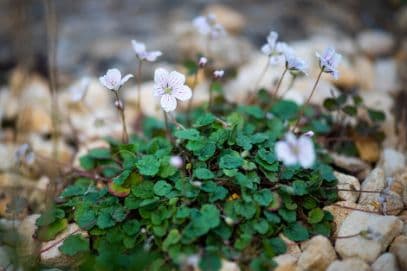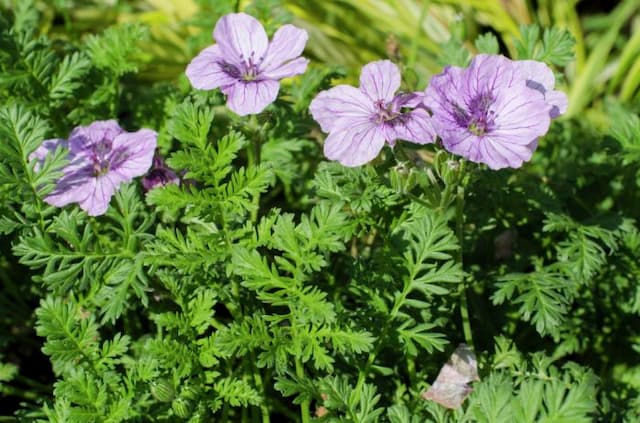Geranium asphodeloides does not have a commonly recognized common name. Geranium asphodeloides

ABOUT
The Geranium asphodeloides, widely known as the Hardy Geranium, is a visually appealing perennial with distinct features that make it a favorite among gardeners. It showcases a beautiful mound of foliage, with leaves that are often rounded in shape, showcasing deep lobes and a lush green hue that can add texture and depth to any garden setting. The plant is admired for its abundant flowering, producing a profusion of blooms that can come in a variety of colors such as pink, violet, purple or blue. Each flower typically consists of five petals, which are predisposed to radiate outwards, creating a shape that somewhat resembles an open hand. These flowers are carried on delicate stems that rise above the foliage, forming an attractive contrast with the leaves below. What truly sets the Hardy Geranium apart is its extended blooming period, which can last from early summer until the first frost, offering a prolonged display of color. The blossoms are not only a visual delight but are also known to attract pollinators such as butterflies, adding vitality to the garden. Beneath the blooms, the textured foliage sometimes changes color as the seasons transition, often developing reddish tones in the Autumn, providing additional visual interest as the garden palette changes. All in all, the Hardy Geranium is a plant with a graceful habit, presenting its foliage and flowers in a way that complements many other plants in the garden while still being able to stand out with its prolonged and vibrant floral display.
About this plant
 Names
NamesFamily
Geraniaceae
Synonyms
Geranium Asphodeloides
Common names
Geranium asphodeloides.
 Toxicity
ToxicityTo humans
Geranium asphodeloides, commonly known as hardy geranium, is generally not regarded as a toxic plant to humans. There is limited information suggesting that it has any significant toxicity, and it is often grown in gardens where incidental contact may occur without concern. However, as with any plant, individuals may have allergies or sensitivities to it. It is always advised to be cautious and avoid ingesting plants that are not specifically known to be edible. If any part of this plant were to be ingested, it is unlikely to cause more than mild gastrointestinal discomfort, but if symptoms occur or there is a concern about ingestion, medical advice should be sought.
To pets
Hardy geranium is also not typically considered toxic to pets. It does not appear on common lists of plants that are poisonous to pets, such as those compiled by the ASPCA. Nevertheless, pets, like humans, can have varying sensitivities, and consumption of non-food plant material can potentially cause gastrointestinal upset in some animals. If a pet were to ingest part of a hardy geranium plant, it could possibly experience mild vomiting or diarrhea. In the case of any adverse reaction or a large amount being consumed, it is important to consult with a veterinarian.
 Characteristics
CharacteristicsLife cycle
Perennials
Foliage type
Deciduous
Color of leaves
Green
Flower color
Pink
Height
1-2 feet (30-60 cm)
Spread
1-2 feet (30-60 cm)
Plant type
Herb
Hardiness zones
5
Native area
North America
Benefits
 General Benefits
General Benefits- Aesthetic Appeal: Geranium asphodeloides, commonly known as the geranium, offers vibrant flowers and aesthetically pleasing foliage that can enhance the beauty of gardens and landscapes.
- Attracts Pollinators: The blossoms of geraniums are known to attract beneficial pollinators like bees and butterflies, which are essential for the pollination of many plants.
- Erosion Control: Geraniums can contribute to soil stabilization and erosion control thanks to their root system which helps to hold the soil in place.
- Drought Tolerance: Once established, some varieties of geraniums are capable of withstanding periods of drought, making them suitable for xeriscaping and low-water gardens.
- Low Maintenance: Geraniums typically require minimal maintenance, making them a convenient choice for gardeners of all skill levels.
- Versatile Landscaping: They can be used in a variety of landscaping designs, including as ground cover, in borders, or as container plants.
- Seasonal Interest: With their long blooming period, geraniums provide color and visual interest throughout the growing season, often from spring to fall.
- Companion Planting: Geraniums can be beneficial when planted alongside other species by repelling certain pests naturally, thus fostering a healthier garden ecosystem.
- Wildlife Habitat: These plants can offer shelter and food sources for wildlife, thereby supporting local biodiversity.
 Medical Properties
Medical Properties- This plant is not used for medical purposes.
 Air-purifying Qualities
Air-purifying QualitiesThis plant is not specifically known for air purifying qualities.
 Other Uses
Other Uses- Insect Repellent: Geranium can emit a fragrance that is unpleasant to various insects and thus can be used as a natural repellent when planted in gardens or near outdoor living spaces.
- Decorative Dried Flowers: Geranium flowers can be dried and used in decorative flower arrangements, retaining their color and shape for a long period.
- Fabric Dye: The petals and leaves of some geranium species can be used to create natural dyes for fabrics.
- Culinary Decoration: Edible species of geranium can have their petals used as a colorful garnish for salads and desserts.
- Stress Relief: The scent of geranium is often considered soothing and is used in aromatherapy to reduce stress and enhance relaxation.
- Fragrance Production: Geranium oil is used in perfumes and body lotions for its rose-like fragrance.
- Garden Companion Planting: Geraniums can be used in companion planting to help protect vegetables and other plants from pests or diseases.
- Botanical Art: Geranium plants and flowers can be utilized by botanical artists for their interesting leaf shapes and vibrant flowers.
- Geranium Oil in Candle Making: The essential oil extracted from geranium can be used in candle making, providing a floral scent to homemade candles.
- Crafting Potpourri: Dried geranium leaves and petals can be mixed with other botanicals to create a fragrant potpourri.
Interesting Facts
 Feng Shui
Feng ShuiThe Geranium is not used in Feng Shui practice.
 Zodiac Sign Compitability
Zodiac Sign CompitabilityThe Geranium is not used in astrology practice.
 Plant Symbolism
Plant Symbolism- Protection: Geraniums are often associated with safeguarding against negative influences, which might stem from the strong fragrance of some geranium species thought to repel harmful insects.
- Healing: With its use in traditional medicine, geraniums symbolize health and recovery, implying that the presence of the plant can contribute to the healing process.
- Friendship: Geraniums can represent close bonds and positive relationships, suggesting that giving a geranium is a way of extending friendship or deepening a connection with someone.
- Peace: The calming and soothing essence of geraniums, be it through their scent or appearance, conveys a message of peace and tranquility.
- Fertility: Geraniums' prolific nature and easy propagation might symbolize fertility and the idea of growth or creation in various aspects of life.
 Water
WaterHardy Geraniums, including Geranium asphodeloides, sometimes known as "Wild Cranesbill," prefer well-drained soil and do not like to sit in overly wet conditions. It's best to water the plant deeply once a week, providing about 1 to 2 inches of water each time. During hot or dry periods, you might need to water twice a week, but always check the soil moisture before watering to prevent overwatering. Over the course of a month, you should expect to use about 3 to 5 gallons of water per plant, depending on the climate and soil conditions.
 Light
LightWild Cranesbill thrives in full sun to partial shade. It is adaptable but does best with several hours of direct sunlight each day, though it should be protected from the intense, scorching afternoon sun in hot climates. A spot that receives morning sunlight and dappled shade in the afternoon is ideal for this plant.
 Temperature
TemperatureGeranium asphodeloides, or Wild Cranesbill, grows best in temperate conditions and can handle a temperature range from about 50 to 75 degrees Fahrenheit. Although it can survive slight frosts and temperatures down to about 20 degrees Fahrenheit, prolonged exposure to extremes can be harmful. The ideal growing temperature for this perennial is between 60 and 70 degrees Fahrenheit.
 Pruning
PruningPruning Wild Cranesbill helps to maintain its shape and encourages fresh growth. It's best to prune in early spring or after the plant has finished flowering. Remove dead or damaged leaves and stems, and cut back up to one-third of the plant to promote bushy growth. Pruning every year or every other year will keep the plant rejuvenated.
 Cleaning
CleaningAs needed
 Soil
SoilHardy Geraniums like Geranium asphodeloides thrive best in well-drained soil that is rich in organic matter. A mix of two parts garden soil, one part peat moss or compost, and one part perlite or coarse sand creates an ideal growing medium. This plant prefers a soil pH between 5.8 and 6.3.
 Repotting
RepottingHardy Geraniums generally don't need frequent repotting; doing so every 2 to 3 years is adequate. It's best to repot in spring before new growth begins.
 Humidity & Misting
Humidity & MistingHardy Geraniums are adaptable to various humidity levels and do well in average room humidity conditions. Just ensure that the area is well-ventilated and not overly dry.
 Suitable locations
Suitable locationsIndoor
Place in bright, indirect light and ensure good air circulation.
Outdoor
Choose a spot with morning sun and afternoon shade.
Hardiness zone
4-8 USDA
 Life cycle
Life cycleGeranium asphodeloides, commonly known as the Wood Geranium, begins its life cycle as a seed, which upon finding suitable moist and well-drained soil conditions, germinates in the spring. The seedling emerges, developing a rosette of leaves and a deep taproot. As it matures, the Wood Geranium develops a flowering stem, with the flowers typically blooming from late spring to early summer. After pollination, which is often done by insects, the flowers produce a distinctive beaked fruit capsule that can launch seeds some distance from the parent plant. These seeds may enter a period of dormancy until the next suitable growing season. The plant is a perennial, so once established, it retreats to its rootstock in winter and regrows in the following spring, repeating the cycle.
 Propogation
PropogationPropogation time
Spring to Summer
Propogation: Geranium asphodeloides, commonly known as the hardy geranium or cranesbill, is often propagated through division. This is typically done in the spring or fall. The process involves digging up an established clump of the plant and gently separating it into smaller pieces, ensuring that each section has a portion of root and a few shoots. This method encourages quick establishment and flowering within the same season. Carefully replant the divisions at the same soil depth they were originally growing, water them in well, and maintain consistent moisture as the new plants establish.



![Cranesbill [Blue Sunrise]](/_next/image?url=https%3A%2F%2Fplants-admin.emdemapps.com%2Fimages%2Fplants%2F%2Fimages%2F604b638d45948.png&w=640&q=75)





![Cranesbill [Dreamland]](/_next/image?url=https%3A%2F%2Fplants-admin.emdemapps.com%2Fimages%2Fplants%2F%2Fimages%2F604b53d4c45a1.png&w=640&q=75)